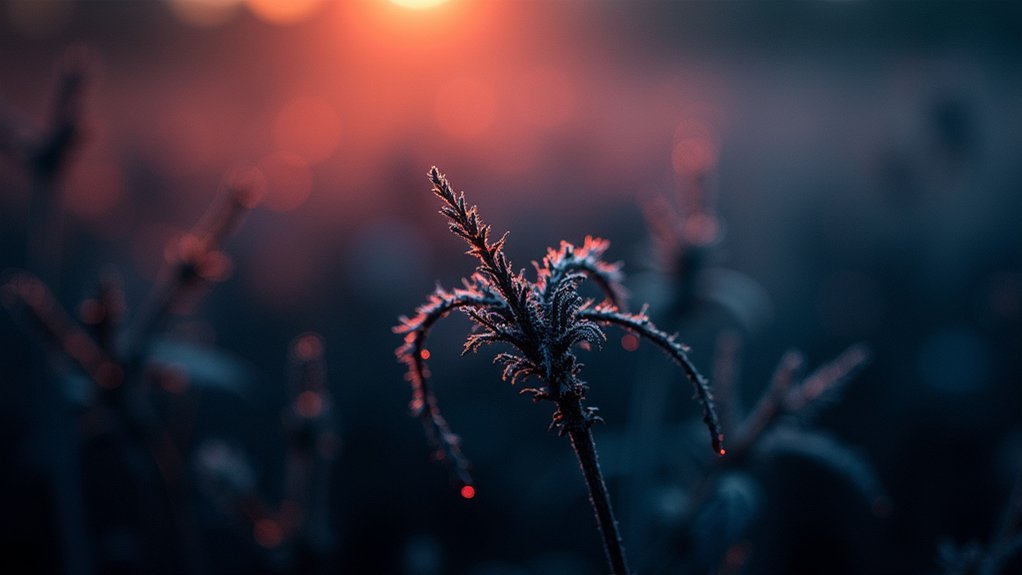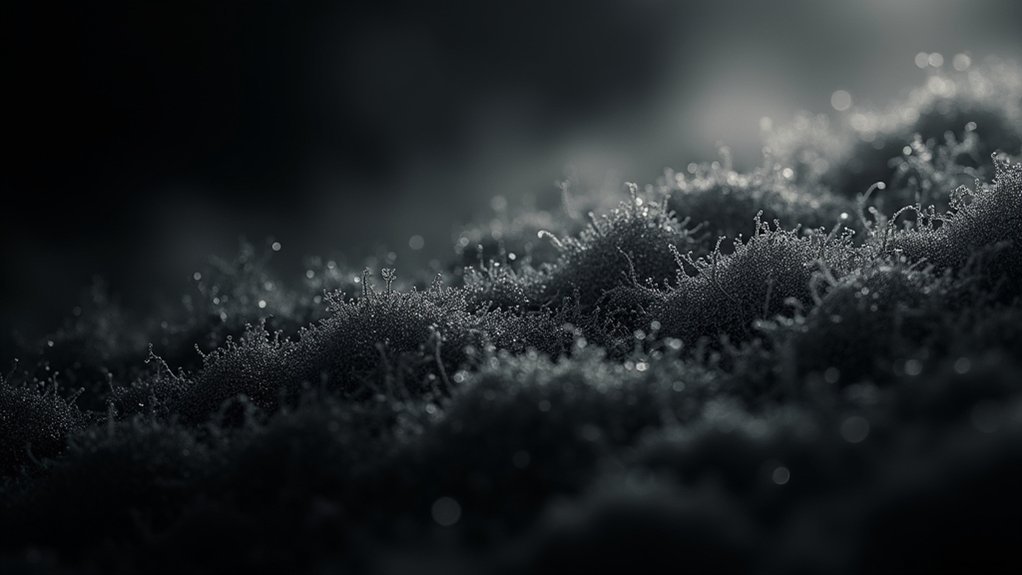The best digital noise filters for dark field images include Topaz DeNoise AI, dark frame subtraction, wavelet-based filtering, multi-image stacking, DnCNN-P deep learning networks, adaptive thresholding, and GPU-accelerated real-time filters. These solutions tackle Gaussian, Poisson, and speckle noise while preserving critical details. You’ll achieve up to 89% noise reduction when properly calibrated with matched exposure times and temperature settings. Discover how these specialized techniques can transform your microscopy and low-light imaging results.
7 Best Digital Noise Filters For Dark Field Images

Three major challenges plague dark-field images in medical settings: Gaussian noise, Poisson noise, and the risk of lost diagnostic details. To overcome these obstacles, you’ll need specialized digital noise filters designed specifically for medical imaging applications.
The most effective solution today is deep learning algorithms like DnCNN-P, which demonstrate remarkable noise reduction capabilities while preserving critical image details. These advanced filters achieve up to 89.1% reduction in standard deviation, dramatically enhancing image quality for diagnostic purposes.
Modern noise reduction software leveraging convolutional neural networks has revolutionized dark-field image processing across various modalities, including X-ray differential phase imaging.
Topaz DeNoise AI: Advanced Machine Learning for Microscopy
When examining specimens under dark field microscopy conditions, you’ll often encounter significant noise that obscures vital details.
Topaz DeNoise AI tackles this challenge through advanced machine learning algorithms specifically designed to reduce digital noise while preserving essential structural information.
Powerful AI algorithms eliminate digital noise while maintaining critical structural details in microscopy specimens.
The software’s low-light mode excels with high-ISO images, making it invaluable for microscopy applications where lighting is often limited.
You’ll appreciate the intuitive interface that doesn’t require extensive technical expertise to achieve professional results.
As both a standalone application and noise reduction plugin for Adobe Photoshop and Lightroom, Topaz DeNoise integrates seamlessly into your existing workflow.
The selective mask feature lets you target specific image areas, maintaining detail where needed while removing noise elsewhere—particularly useful when working with complex microscopy specimens that require varying levels of processing.
Dark Frame Subtraction Techniques for Dark Field Imaging

Dark frame subtraction delivers ideal results when you’ll match your dark frame temperature to your primary exposure, preventing thermal noise discrepancies.
You can choose between capturing sequential dark frames after each image or creating a master dark frame library organized by ISO, exposure duration, and temperature.
Calibrating your exposure times guarantees proper noise pattern alignment, particularly important when attempting to eliminate hot pixels and sensor artifacts in dark field microscopy images.
Temperature Matching Considerations
Since thermal variations directly influence sensor behavior, the effectiveness of dark frame subtraction hinges on precise temperature matching between your dark frames and target images.
When your dark frames aren’t captured at the same sensor temperature as your actual images, you’ll introduce inaccuracies in noise reduction that can degrade rather than improve quality.
For ideal temperature matching results:
- Capture your dark frames immediately after your target images to maintain consistent sensor temperature conditions.
- If using manual dark frame subtraction in post-processing, account for any temperature differences by adjusting subtraction intensity.
- Consider disabling your camera’s automatic long exposure noise reduction when temperature fluctuations are significant, as the built-in feature doesn’t compensate for thermal variations.
Temperature matching remains critical regardless of whether you’re using automated or manual dark frame subtraction techniques.
Sequential vs. Master Frames
As you venture deeper into dark frame subtraction techniques, you’ll encounter two primary methodologies that greatly impact your dark field imaging results: sequential frame subtraction and master frame application.
Sequential dark frame subtraction uses individual frames matched to each light exposure’s settings, providing precise noise removal tailored to your sensor’s specific behavior. This approach excels at addressing unique noise patterns but requires more storage space.
In contrast, master frame subtraction combines multiple dark exposures into a single averaged reference frame. You’ll achieve enhanced noise reduction by averaging out random noise components across several frames. This method offers efficiency and typically delivers superior results when you’re working with multiple images.
For best results, verify proper alignment between your dark and light frames regardless of which method you choose.
Exposure Time Calibration
Matching your exposure times precisely between light and dark frames forms the cornerstone of effective noise reduction in dark field imaging.
Dark frame subtraction effectively eliminates hot pixels and thermal noise that contaminate your images during long exposures. You’ll achieve peak image quality by ensuring both frames share identical settings.
To properly calibrate your exposure times:
- Capture dark frames with the same exposure time and ISO as your light frames, keeping your lens cap on.
- Match temperature conditions when possible, as thermal noise varies with ambient temperature.
- Subtract immediately after shooting to reduce noise while details remain fresh.
This calibration process might seem tedious, but it’s essential for preserving critical details in your dark field images, especially when working with high ISO settings that amplify sensor noise.
Wavelet-Based Filtering Methods for Preserving Fine Structures

You’ll find wavelet decomposition transforms dark field images across multiple frequency bands, separating noise from structural elements at various resolution scales.
This multi-scale representation lets you target noise removal precisely where it occurs while maintaining essential fine structures that traditional filters might blur.
Wavelet Decomposition Fundamentals
The elegance of wavelet decomposition lies in its ability to analyze images at multiple scales simultaneously. You’ll find this mathematical approach particularly valuable when working with dark field images where preserving fine structures during noise reduction is vital.
Wavelets adapt to both local and global features, making them ideal for detail preservation in challenging lighting conditions.
When applying wavelet-based filtering to your dark field images, you’ll benefit from:
- Selective frequency processing – Target noise without compromising important image details
- Adaptive thresholding – Apply soft or hard wavelet thresholding to optimize noise reduction
- Multi-resolution analysis – Preserve edges and textures at different scales simultaneously
Unlike traditional filters, wavelet decomposition excels at maintaining essential fine structures while effectively removing noise—a significant balance in dark field imaging applications.
Structure-Preserving Scale Analysis
Structure-preserving scale analysis represents a notable advancement in wavelet-based filtering methods specifically designed for dark field images.
You’ll find these techniques particularly valuable when working with astrophotography or medical imaging where preserving fine details is essential.
When you apply wavelet-based filtering, your images benefit from selective noise reduction across different frequency components. Unlike traditional methods that often blur important features, this multiscale analysis approach differentiates between actual signal and unwanted noise. The result? Superior detail retention in your dark field images.
What makes this approach exceptional is how it minimizes artifacts while maintaining vital structural information.
Recent algorithmic improvements have further enhanced these capabilities, offering you remarkably better performance than conventional denoising techniques when working with images containing intricate structures in low-light conditions.
Multi-Image Stacking and Registration for Noise Reduction
When capturing dark field images, one of the most effective techniques for reducing digital noise involves multi-image stacking and registration. By shooting multiple exposures in quick succession, you’ll enhance your signal-to-noise ratio by approximately 1.4 times.
Registration techniques, available in software like DeepSkyStacker, precisely align star positions across frames, averaging out noise while preserving critical details.
Here’s why you should incorporate multi-image stacking into your workflow:
- Median stacking (using Smart Objects) provides superior noise reduction, especially with more exposures.
- The process considerably increases dynamic range, giving you greater flexibility during post-processing.
- You can combine lower ISO foreground exposures with stacked background images for ideal detail retention.
This approach delivers cleaner images without sacrificing the fine details that make dark field photography remarkable.
Deep Learning Convolutional Networks for Microscope Photography

Recent advances in artificial intelligence have revolutionized dark-field microscope photography, particularly through specialized deep learning convolutional networks.
The DnCNN-P algorithm stands out as a purpose-built solution for X-ray differential phase and dark-field images, offering superior noise reduction while preserving critical details.
This network employs three layers of convolution with ReLU functions and 64 filters sized 3×3×1, optimizing feature extraction from noisy inputs.
You’ll notice significant improvements in image quality across varying photon counts and visibilities compared to traditional methods.
The algorithm effectively tackles Gaussian, Poisson, and speckle noise—common challenges in dark-field microscopy.
Real-Time Noise Reduction Solutions for Live Dark Field Imaging
Real-time noise reduction represents the next frontier in dark-field microscopy applications, extending the capabilities of algorithms like DnCNN-P into live imaging environments.
When you’re capturing live specimens, advanced algorithms must process and filter various noise types instantly to maintain diagnostic value without introducing delays.
For ideal results in live dark field imaging, consider these critical developments:
- Intelligent adaptive filters that dynamically adjust to changing noise patterns while preserving delicate structural details
- Low-latency processing frameworks capable of handling Gaussian, Poisson, and speckle noise simultaneously
- GPU-accelerated implementations that enable complex noise reduction technologies to operate within millisecond timeframes
These real-time solutions are particularly valuable in low-dose biomedical applications where minimizing radiation exposure while maintaining image clarity is essential.
Frequently Asked Questions
How Do I Reduce the Noise in a Dark Picture?
You’ll get cleaner dark images by lowering your ISO, using noise reduction software like Topaz DeNoise, applying dark frame subtraction, stacking multiple exposures, and using selective editing to preserve details.
What Is the Best Filter to Remove Noise?
For removing noise, Topaz DeNoise AI is your best option. It uses advanced AI technology to effectively reduce noise while preserving important details. DxO PureRAW 2 is another excellent choice for detail conservation.
Does Noise Reduction Reduce Image Quality?
Yes, excessive noise reduction can reduce image quality. You’ll lose details and create plastic-like artifacts. However, when applied properly, it enhances quality by removing unwanted noise while preserving essential details in your photos.
What Is the Best Noise Reduction in Lightroom?
Lightroom’s best noise reduction is the AI Denoise feature. You’ll get superior results compared to traditional luminance and color sliders while preserving more detail. It’s particularly effective for astrophotography and low-light images.
In Summary
You’ve now discovered the top noise reduction tools for dark field microscopy. Whether you’re using DeNoise AI’s machine learning capabilities or implementing dark frame subtraction, you’ll achieve cleaner results while preserving critical details. Don’t forget to explore wavelet filtering, image stacking, and deep learning networks. With these solutions at your disposal, you’re well-equipped to overcome the imaging challenges that once limited your dark field photography.





Leave a Reply